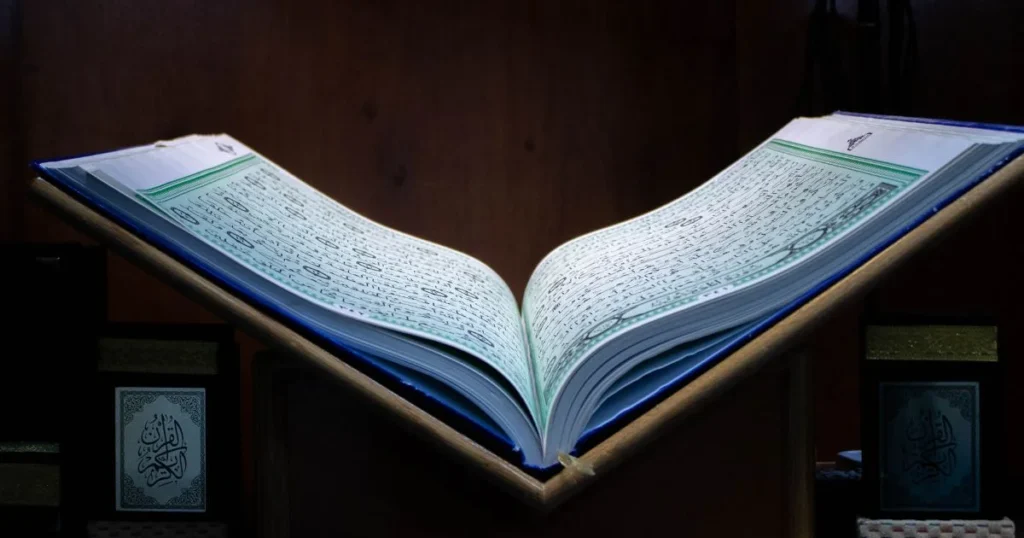
Rules of Waqf In Quran :
In the rhythmic cadence of Quran recitation, the concept of Waqf holds a sacred significance. Qirat Quran Online, a distinguished Online Quran teaching academy, takes pride in unraveling the intricacies of Waqf, offering insight into its meaning and rules. In this detailed blog post, we will explore the essence of Waqf in the Quran, decoding its meaning, identifying Waqf signs, and delving into the rules that govern this divine pause in recitation.
Waqf Meaning
This section introduces the fundamental concept of Waqf, highlighting its profound meaning and significance in Quran recitation.
Definition of Waqf:
At its core, Waqf in the Quran refers to a deliberate pause or stop in recitation. It is a symbolic act of reverence, acknowledging the sanctity of the words being recited and allowing the reciter and the listener to absorb the divine message.
Quran Waqf Signs
The Holy Quran is regarded as one of the world’s holiest books among all holy Books. It is unique among all texts in the world and provides both Muslims and non-Muslims with divine instruction.
Unlike other writings in the world, the Holy Quran is unique and ought to be regarded as such. The actual meaning of the Qur’an is conveyed when it is recited with proper pronunciation and tone. Muslims’ relationship with God is strengthened and their faith is deepened when they abide by these guidelines.
In order to aid you in this process, we have put together a thorough list of methods for reading the Quran that you can use independently and that you can also educate your kids to follow. This will guarantee that the Holy Book is correctly recited and understood and will also serve to fortify your relationship with God Almighty.
Quran Waqf Rules
Whether reciting the Quran for memorizing or during daily prayers, following the Quran halting guidelines is vital for accurate pronunciation. These guidelines are also referred to as “Tajweed,” which is the skill of correctly pronouncing and intonating the Quran. It is stated that in order to fully experience the spiritual and affective power of the Quran, the reader must adhere to the Tajweed guidelines when repeating the verses.
The expert Quran educators at Qirat Quran Online have supplied the following 18 crucial guidelines for reading the Quran.
1. The Conclusion of Verse
A sukoon, a brief pause, indicates the end of an Ayah (verse) in the Quran. After finishing an ayah, it is advised that readers take a moment to consider its significance and meaning.
To completely experience the spiritual impact of Quran recitation, one must recite the Quran with correct pronunciation, intonation, and pausing at the appropriate times.
2. مـ – The Compulsory Stop
One of the letters linked to the required pause (waqf) during Quran recitation is “م” (Meem).
According to the tajweed rules, there must be a pause when reciting specific verses of the Quran. This is known as the compulsory stop. This pause is crucial; otherwise, the verse’s meaning could be interpreted differently.
The mandatory pause can happen in the middle of a word or at the conclusion of a word depending on the situation.
3. ط – The Absolute Pause
The Arabic term for the symbol “ط” is “waqf e mutlaq,” which means “absolute pause.” When reciting the Quran, this symbol is used to denote a complete pause in the reading process.
The reader must pause for a moment, take a breath, and then resume the recitation when they encounter this sign. There are several reasons why this break is crucial.
First of all, it enables the reader to pause and collect their breath—a crucial feature during lengthy recitations.
Second, it facilitates the reader’s ability to pace and keep a steady beat throughout the recitation.
Lastly, it acts as a visual cue to guide the reader through the text and help them avoid typos or mispronunciation issues.
4. ج – The Permissible Stop
The Arabic character “ج” denotes a legal pause, or “waqf e jaaiz.”
It signals the end of an idea or subject in a verse of the Quran and asks the reader to take a moment to reflect before moving on. While stopping now is not required, it is highly recommended in order to properly comprehend the meaning of the passages that came before.
It offers a nice break for the reader to catch their breath and compose themselves before moving on.
5. ز – Continue Reading
In Arabic, the mark “ز” denotes a waqf e mujawwaz, or “keep reading.” This symbol means that the reader should continue reciting the Quran uninterrupted, without pausing, at this point. It’s crucial to remember that the reader is free to pause at this point if necessary and that doing so is not prohibited.
6. ص – The Licensed Pause
In Arabic, the mark “ص” denotes a waqf e murakh-khas, or authorized pause. This sign designates a particular kind of pause that is acceptable in some situations. The waqf e murakh-khas is only utilized in certain situations, such as when the reader is too tired or exhausted to continue reading, in contrast to the waqf e jaaiz and waqf e mujawwaz.
This signal suggests that before continuing with the recitation, the reader should halt for a moment to gather themselves and collect their breath. It’s crucial to remember that the reader may only take this break if they are truly exhausted. Should the reader be able to proceed uninterrupted, they ought to do so.
7. صلي – Preference for Continuation
The Arabic term “صلي” denotes the reciting rule known as al-wasl awlaa, which translates to “preference for continuation.” This rule is founded on the idea that it is preferable to recite the Quran continuously rather than taking unnecessary breaks.
8. ق – Better not to Stop
The Arabic symbol “ق” denotes the reciting guideline known as qeela ‘alayhil-waqf, which translates to “better not to stop.” According to this rule, it is preferable to recite the Quran continuously at specific moments rather than hesitating needlessly.
On the practical application of this rule, however, scholarly viewpoints diverge.
Even if the qeela ‘alayhil-waqf indication exists, some scholars contend that there are specific places in the Quranic text when it is permissible to pause or stop for a short while. This could be done to emphasize or clarify particular themes, or to better communicate the verses’ intended meaning.
9. صل – The Permissible Pause
In Arabic, the symbol “صل” denotes the reciting guideline known as qad yusal, or “the permissible pause.” Despite the fact that the symbol itself suggests that the recitation should continue, this regulation permits the reciter to take a brief break at specific points in the performance.
It is crucial to remember that the qad yusal symbol designates a permitted pause rather than an obligatory one throughout the recitation.
10. قف – The Anticipation Mark
“قف” or “qif” is an anticipation mark in Arabic that denotes a stop or pause in a sentence where the reader might anticipate that the sentence will go on without a pause. It is used specifically to signal a break or pause in a sentence that the reader might not immediately notice. It is comparable to an English period or full stop.
11. س – The Silence Symbol
“سكتة,” also known as “saktah,” is an Arabic sign that denotes a momentary halt in speech without really stopping the breath. Similar to an English comma or semicolon, it is used especially to denote brief pauses that don’t call for a breath.
In formal written and spoken Arabic, “saktah” is frequently employed to establish rhythm and flow in the sentence. It can also be used to signal a shift in the sentence’s emphasis or tone.
12. وقفتہ – The Longer Pause
“وقفة,” also known as “waqfah,” is a symbol in Arabic that can be used to denote a prolonged pause in a sentence without really stopping the sentence’s flow. It is used expressly to denote a prolonged pause that does not require a breath, much like an English period or full stop.
13. لا – No Need of Stopping
The word “لا” or “laa” is not a punctuation mark that has to be stopped or paused; rather, it is frequently used throughout the Quran to express negation or denial. In contrast to other Arabic punctuation, “laa” is used to emphasize a point or refute a statement rather than to signal a break in the sentence’s flow.
It is significant to remember that the word “laa” does not function as a punctuation mark in Quranic verses, necessitating a halt or pause.
14. ∴ – The Embracing Stop
The Arabic term for this symbol is “Mu’anaqah,” which implies “embracing” or “entwining.” The Quran uses a diacritical mark called mu’anaqah on the final letter of a word to tell the reciter to pause and catch their breath before moving on to the next verse.
The Quran is widely recognized for its exquisite and poetic language, and the deliberate insertion of Mu’anaqah enriches the verses’ rhythmic and poetic flow.
15. وقف النبی – The Pause of Prophet PBUH
The phrase “the pause of the Prophet,” or Waqf-un-Nabi, refers to a Sunnah—a model established by the Prophet Muhammad SAW—that is adhered to when reciting the Quran. Muslims strive to recite the Quran in the same manner as the Prophet Muhammad SAW did.
It is said that when reciting the Quran, the Prophet Muhammad SAW would occasionally halt or pause.
These breaks were based on the Prophet’s own recitation rather than being denoted by any particular symbol or diacritical mark. It is believed that these breaks are a component of the Sunnah.
16. وقف غفران – The Sign of Supplication
The Arabic phrase “Waqf e Ghufraan” means “a pause for forgiveness.” In Islamic writings, like the Quran, this symbol is frequently used to alert readers to the need to pause and ask Allah for forgiveness.
When a reader encounters this symbol while reading an Islamic scripture or reciting the Quran, they should immediately stop reading and offer a brief prayer asking Allah for forgiveness. This interlude gives the reader time to consider the lesson they just read and ask for pardon for any transgressions they may have done.
17. وقف منزل – The Pause Sign of Jibrael
The Arabic phrase “Waqf e Manzil” means “pause at a designated place.” The Quran uses this sign to denote a pause or stop that the Angel Jibrael would make when giving the Prophet Muhammad (PBUH) access to Quranic passages.
The Waqf e Manzil symbol in the Quran communicates to the reader that they too should pause and contemplate. The Angel Jibreel would halt at specific moments during the Quran’s recitation as it was revealed to the Prophet Muhammad (PBUH).
Conclusion
In the sacred realm of Quran recitation, Waqf emerges as a poignant expression of reverence and contemplation. Qirat Quran Online, with its commitment to precision and understanding, serves as a guiding light for learners seeking to master the rules of Waqf in the Quran. By unraveling the meaning, identifying Waqf signs, and delving into the rules that govern this divine pause, learners embark on a journey of profound connection with the sacred verses. May the teachings of Qirat Quran Online illuminate the path to respectful and eloquent Quran recitation, where each Waqf becomes a moment of spiritual enrichment and deep connection with the divine words.
FAQS:
The rule of Waqf in Quran recitation refers to pausing or stopping at designated points.
Waqf in the Quran signifies a pause or stop at specific words or phrases.
The Arabic letter “قف” (Qaf) in the Quran indicates a mandatory stop.
The Arabic letter “ط” (Taa) in the Quran signifies a non-mandatory stop, allowing for a pause.
Share on >>
